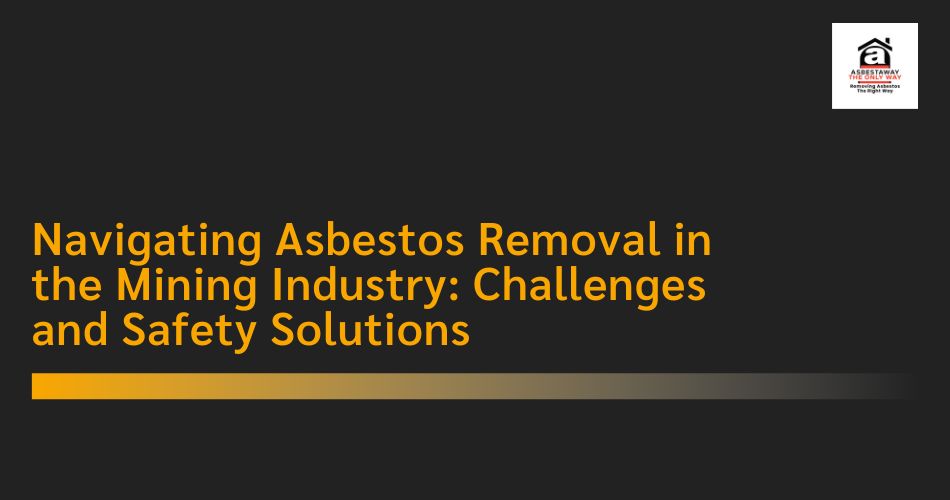Asbestos, once hailed as a wonder material for its durability and heat resistance, was widely used in industries such as construction, shipbuilding, and mining. However, over the years, the serious health risks associated with asbestos exposure, including lung cancer, asbestosis, and mesothelioma, have led to its ban in many countries. Despite its known hazards, asbestos remains present in many older mining operations, where it was used in insulation, equipment, and other critical applications.
Asbestos removal in the mining industry presents unique challenges due to the inherent risks involved in handling the material in active, sometimes remote, industrial environments. In this blog, we’ll delve into the complexities of asbestos removal in the mining industry, discuss the safety concerns that must be addressed, explore the regulatory environment, and provide practical solutions to ensure the safe and compliant removal of asbestos.
Understanding Asbestos in Mining
Asbestos was once widely used in mining operations due to its ability to withstand extreme heat, resist corrosion, and improve durability. It was often utilized in various forms such as insulation for pipes, boilers, and electrical equipment, as well as in fireproofing materials, gaskets, and even flooring. The mining industry itself also exposed workers to asbestos fibers through the extraction of minerals that were naturally contaminated with asbestos, including vermiculite, talc, and certain types of mica.
When disturbed, asbestos fibers become airborne and can be inhaled into the lungs, leading to serious health issues over time. In mining, where equipment is routinely maintained and environments are subject to physical disturbances such as drilling and blasting, the risk of asbestos fiber release is high. This makes the process of removing asbestos particularly complex and hazardous in these environments.
The Risks of Asbestos Exposure in Mining
The primary health risks associated with asbestos exposure in the mining industry are well-documented and include:
- Asbestosis: A chronic lung disease caused by inhaling asbestos fibers that leads to scarring of lung tissue. It can result in severe shortness of breath, fatigue, and eventual respiratory failure.
- Mesothelioma: A rare but aggressive cancer that affects the lining of the lungs, abdomen, or heart. It is almost exclusively caused by asbestos exposure.
- Lung Cancer: Long-term exposure to asbestos increases the risk of lung cancer, especially when combined with smoking.
- Pleural Disease: The lining of the lungs can become thickened or develop plaques after exposure to asbestos, which can cause chest pain and difficulty breathing.
In the mining industry, workers are exposed to a range of asbestos-containing materials (ACMs) during the extraction, handling, and processing of ores and minerals. The continuous movement of machinery and equipment in an often dusty, confined, and high-risk environment increases the likelihood of asbestos fibers becoming airborne. This means that the need for effective asbestos removal is paramount to protect the health of miners and others working in and around the mining site.
Key Challenges of Asbestos Removal in the Mining Industry
Asbestos removal in mining operations is far from a simple process. Given the unique challenges presented by the mining environment, the removal process requires a strategic approach, skilled personnel, and the right equipment. Here are the main challenges faced during asbestos removal in mining:
1. Difficult Working Conditions
Mining environments are often harsh and dangerous, with difficult working conditions that pose significant challenges during asbestos removal. Mines, particularly underground operations, are subject to issues such as:
- Limited Access: Mining sites, especially those underground, often present tight and confined spaces that are challenging to access. This makes it difficult to reach areas that may contain asbestos, such as pipes, insulation, or machinery.
- High Dust Levels: Dust is an inherent risk in mining operations, and asbestos fibers can easily mix with regular dust. This makes it more difficult to detect and contain asbestos fibers in the air, increasing the risk of exposure.
- Extreme Temperatures: In some mining operations, high temperatures are prevalent, particularly in the case of geothermal or coal mines. This can increase the likelihood of asbestos-containing materials degrading, releasing fibers into the environment.
These harsh conditions make it challenging for workers to safely remove asbestos without being exposed to potential hazards. Specialized equipment, proper ventilation, and a controlled environment are critical to mitigating these risks.
2. Identification and Removal of Asbestos-Containing Materials (ACMs)
Asbestos may be present in various forms throughout a mining operation, including in equipment, structures, insulation, or even within the minerals being mined. Over time, the materials may have deteriorated, leading to the release of fibers into the air.
The identification of asbestos is not always straightforward. Materials may have been altered or may no longer be easily identifiable. Furthermore, asbestos could be hidden within layers of other materials, making it difficult to spot. Mining companies must undertake comprehensive inspections and testing to locate any hidden asbestos before proceeding with removal.
The removal of ACMs, particularly when they are mixed with other industrial waste or buried deep within mining infrastructure, can require significant planning, demolition, and labor.
3. Worker Health and Safety
The health and safety of workers during the asbestos removal process is paramount. Mining environments, by their very nature, already present significant risks to workers, such as falls, equipment accidents, and exposure to toxic gases or dust. Adding asbestos removal to the list of hazards complicates the situation further.
Ensuring that workers are properly trained, equipped with personal protective equipment (PPE), and working in controlled environments is crucial to minimizing the risk of exposure. This includes providing:
- Respiratory Protection: Specialized, high-filtration respirators are necessary to protect workers from inhaling airborne asbestos fibers.
- Protective Clothing: Workers should wear full-body suits that prevent asbestos fibers from settling on their skin or clothing.
- Decontamination Procedures: Workers must undergo decontamination procedures to remove any asbestos particles from their clothing or equipment after leaving the work area.
These measures are essential to ensure the safety of workers and minimize the risk of long-term health issues.
4. Environmental Contamination and Disposal
Asbestos removal is not just about protecting workers. Environmental contamination is also a significant concern. If asbestos fibers are released into the surrounding environment, they can spread to neighboring areas, posing risks to nearby communities, wildlife, and ecosystems.
Mining companies must take precautions to prevent asbestos from contaminating soil, water, and air. Specialized containment systems, such as sealed work areas and negative air pressure systems, are essential for limiting fiber release during removal.
Proper disposal is also a critical aspect of the removal process. Asbestos waste must be handled and disposed of in designated, licensed disposal sites to ensure that it does not pose a future hazard.
5. Regulatory Compliance
The mining industry is subject to strict regulations surrounding asbestos removal, and compliance with these regulations is crucial. Regulatory bodies such as OSHA (Occupational Safety and Health Administration) in the United States, Safe Work Australia, and similar agencies worldwide have stringent guidelines governing the identification, removal, and disposal of asbestos.
Failure to comply with these regulations can result in hefty fines, legal action, and severe reputational damage for mining companies. Proper documentation, including asbestos surveys, removal records, and disposal certificates, must be maintained to demonstrate compliance with all regulatory requirements.
Best Practices for Asbestos Removal in the Mining Industry
To effectively address the challenges of asbestos removal in mining, companies must follow best practices that ensure both safety and compliance. These practices include:
- Pre-removal Surveys and Risk Assessments: Comprehensive surveys should be conducted to identify asbestos-containing materials across the site. This includes sampling and laboratory analysis to confirm the presence of asbestos.
- Proper Containment and Isolation: A controlled environment must be established during removal, with areas sealed off from the rest of the site to prevent fiber release. Negative air pressure and HEPA filtration systems should be employed to capture any airborne fibers.
- Specialized Training: Workers involved in asbestos removal must undergo specialized training to understand the risks of asbestos exposure and how to use PPE and follow safety protocols.
- Air Monitoring and Post-removal Testing: Continuous air monitoring should be conducted to detect airborne asbestos fibers. Once removal is complete, clearance testing should be performed to ensure that the area is safe for re-entry.
- Waste Disposal: Asbestos waste should be carefully handled, packaged, and transported to licensed disposal sites. Detailed records must be kept to ensure proper disposal.
Asbestaway: A Trusted Partner in Asbestos Removal for Mining
One company that stands out in the field of asbestos removal for the mining industry is Asbestaway. Specializing in high-risk asbestos removal projects, Asbestaway offers a range of services tailored to meet the unique needs of mining operations.
Asbestaway has a team of certified professionals who are trained in managing the complex and hazardous task of asbestos removal in mining environments. The company provides comprehensive services, including pre-removal surveys, asbestos identification, safe removal, air monitoring, and disposal, all in strict compliance with local and international regulations.
By partnering with Asbestaway, mining companies can ensure that their asbestos removal projects are carried out safely, efficiently, and in compliance with all regulatory requirements. Asbestaway’s commitment to quality and safety makes them a trusted choice for asbestos removal in mining operations.
Conclusion
Asbestos removal in the mining industry presents numerous challenges, from harsh working conditions to ensuring the safety of workers and compliance with strict regulations. However, with the right strategies, equipment, and expertise, these challenges can be effectively managed. Mining companies must prioritize the safety of their workforce and the surrounding environment by implementing comprehensive asbestos removal plans.
Partnering with trusted asbestos removal experts like Asbestaway ensures that mining operations can tackle asbestos removal efficiently and safely, minimizing risks to both workers and the environment. The ongoing commitment to safety, regulatory compliance, and effective removal practices will help create a safer future for all involved in the mining industry.

